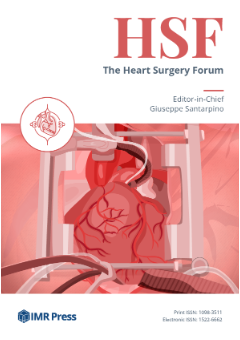Cite this article
2
Downloads
20
Citations
6
Views
Announcements
The Heart Surgery Forum (HSF) is published by IMR Press from Volume 28 Issue 9 (2025). Previous articles were published by another publisher under the CC-BY-NC licence, and they are hosted by IMR Press on imrpress.com as a courtesy and upon agreement.
Open Access
Article
Monitoring Brain Oxygen Saturation During Coronary Bypass Surgery Improves Outcomes in Diabetic Patients: A Post Hoc Analysis
Heart Surg. Forum 2011, 14(1),
1–6;
https://doi.org/10.1532/HSF98.20101065
Published:
23 February 2011
Abstract
Background:Having previously demonstrated in a prospective study of 200 coronary artery bypass (CAB) patients that by using the brain as an index organ, interventions to improve cerebral oxygenation would have systemic outcome benefits, we undertook a post hoc analysis of the diabetic subset (n = 57) of the overall study group to determine whether the outcomes of these patients were similarly improved.Methods:Case-report forms for the 200 CAB patients study patients with a preoperative diagnosis of diabetes mellitus were stratified to intraoperative cerebral regional oxygen saturation (rSO2) monitoring with active display and a treatment intervention protocol (intervention group, n = 28) or to blinded rSO2monitoring (control group, n = 29) and analyzed.Results:There were no significant differences between the 2 groups in overall risk factors, although there were trends toward a higher body mass index, a worse angina score, a worse grade of ventricle, and greater use of off-pump coronary revascularization in the control group of patients. The 2 groups were similar with respect to overall insulin dosage and perioperative blood glucose concentrations. Significantly more diabetic patients in the control group demonstrated profound cerebral desaturation, with an area under the curve of <50%/min (P= .043;d= 0.55), longer intensive care unit (ICU) stays (P= .045;d= 0.58), and longer overall postoperative hospital stays (P= .036;d= 0.47), compared with patients in the intervention group. Compared with the intervention group, the control group had a significantly higher incidence of sternal wound infection (P= .028; ? = 0.31) and a significantly greater number of diabetic patients with >2 postoperative complications (P= .006; ? = 0.37). An analysis after removing the patients who underwent off-pump surgery revealed that the control group had significantly more patients with sternal wound infections (5 versus 0;P= .047) and ?2 postoperative complications (6 versus 0;P= .008) than the intervention group, as well as a trend toward longer ICU and postoperative hospitalization stays in the control group.Conclusion:Monitoring and management of cerebral rSO2in diabetic CAB patients avoid profound cerebral desaturation and are associated with significantly lower incidences of complications and shorter postoperative lengths of stay.Implication Statement:A post hoc analysis of the diabetic cohort of a prospective, randomized, and blinded study of CAB patients revealed that those in whom cerebral oxygen saturation was actively monitored and maintained demonstrated significantly lower incidences of complications, resulting in shorter ICU and postoperative hospital stays compared with an unmonitored control group.

